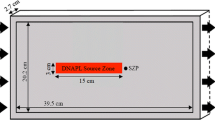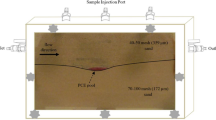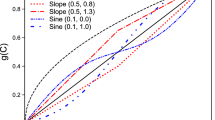Abstract
The accidental release of organic contaminants in the form of non-aqueous phase liquids (NAPLs) into the subsurface is a widespread and challenging environmental problem. Successful remediation of sites contaminated with NAPLs is essential for the protection of human health and the environment. One technology that has received significant attention is the injection of chemical additives (such as cosolvents) upgradient of the NAPL zone for the enhanced dissolution and mobilization of the NAPL mass. A key process influencing the effectiveness of NAPL mass recovery is the interphase mass transfer which is the transfer of components across the interface separating the different phases. In this work, we examine the impact of cosolvent content, flushing solution velocity, and injection pattern (continuous versus intermittent) on the interphase mass transfer rate. A series of flushing experiments were conducted using an intermediate-scale tank which allows for the impact of density variations on DNAPL mobility. The target DNAPL selected in this study was trichloroethylene while the flushing solutions consisted of ethanol–water mixtures with ethanol contents ranging from 0 to 50% by volume. The experimental results were also modeled using the UTCHEM multiphase flow simulator that was modified to model cosolvent flushing. Results show that the observed interphase mass transfer coefficient, expressed as a modified Sherwood number, was much lower than predicted based on published correlations developed under idealized conditions. Moreover, interphase mass transfer rate decreased with time, indicating that a single interphase mass transfer coefficient cannot accurately model the entire flushing solution. The data also suggest that the interphase mass transfer coefficient is dependent on cosolvent content.










Similar content being viewed by others
References
Abriola, L. M. (1989). Modeling multiphase migration of organic chemicals in groundwater systems—a review and assessment. Environmental Health Perspectives, 83, 117.
Agaoglu, B., Scheytt, T., & Copty, N. K. (2012). Laboratory‐scale experiments and numerical modeling of cosolvent flushing of multi-component NAPLs in saturated porous media. Journal of Contaminant Hydrology, 140, 80–94.
Agaoglu, B., Copty, N. K., Scheytt, T., & Hinkelmann, R. (2015). Interphase mass transfer between fluids in subsurface formations: a review. Advances in Water Resources, 79, 162–194.
Akyol, N. H., Yolcubal, I., & Yüksel, D. I. (2011). Sorption and transport of trichloroethylene in caliche soil. Chemosphere, 82(6), 809–816.
Aydin, G. A., Agaoglu, B., Kocasoy, G., & Copty, N. K. (2011). Effect of temperature on cosolvent flooding for the enhanced solubilization and mobilization of NAPLs in porous media. Journal of Hazardous Materials, 186(1), 636–644.
Brooks, R. H., & Corey, A. T. (1966). Properties of porous media affecting fluid flow. Journal of the Irrigation and Drainage Division, 92(2), 61–90.
Brooks, M. C., Annable, M. D., Rao, P. S. C., Hatfield, K., Jawitz, J. W., Wise, W. R., & Enfield, C. G. (2004). Controlled release, blind test of DNAPL remediation by ethanol flushing. Journal of Contaminant Hydrology, 69(3), 281–297.
Brusseau, M. L., Zhang, Z., Nelson, N. T., Cain, R. B., Tick, G. R., & Oostrom, M. (2002). Dissolution of nonuniformly distributed immiscible liquid: intermediate-scale experiments and mathematical modeling. Environmental Science and Technology, 36, 1033–1041.
Childs, J., Acosta, E., Annable, M. D., Brooks, M. C., Enfield, C. G., Harwell, J. H., & Shiau, B. (2006). Field demonstration of surfactant-enhanced solubilization of DNAPL at Dover Air Force Base, Delaware. Journal of Contaminant Hydrology, 82(1), 1–22.
Chiou, C. T., Kile, D. E., Brinton, T. I., Malcolm, R. L., Leenheer, J. A., & MacCarthy, P. (1987). A comparison of water solubility enhancements of organic solutes by aquatic humic materials and commercial humic acids. Environmental Science & Technology, 21(12), 1231–1234.
Corey, A. T. (1994). Mechanics of immiscible fluids in porous media. Water Resources Publication.
Delshad, M., Pope, G. A., & Sepehrnoori, K. (1996). A compositional simulator for modeling surfactant enhanced aquifer remediation, 1 formulation. Journal of Contaminant Hydrology, 23(4), 303–327.
Dokou, Z., & Pinder, G. F. (2011). Extension and field application of an integrated DNAPL source identification algorithm that utilizes stochastic modeling and a Kalman filter. Journal of Hydrology, 398(3), 277–291.
Eichel, H., Helmig, R., Neuweiler, I., & Cirpka, O. A. (2005). Upscaling of two-phase flow processes in porous media. In Upscaling multiphase flow in porous media (pp. 237–257). Springer Netherlands.
Geng, L., Chen, Z., Chan, C. W., & Huang, G. H. (2001). An intelligent decision support system for management of petroleum-contaminated sites. Expert Systems with Applications, 20(3), 251–260.
Hand, D. B. (1939). Dineric distribution: I. The distribution of a consolute liquid between two immiscible liquids. Journal of Physics and Chemistry, 34, 1961–2000.
Hoffman, F. (1993). Ground‐water remediation using “Smart Pump and Treat”. Ground Water, 31(1), 98–106.
Hofstee, C., Ziegler, C. G., Trötschler, O., & Braun, J. (2003). Removal of DNAPL contamination from the saturated zone by the combined effect of vertical upward flushing and density reduction. Journal of Contaminant Hydrology, 67(1), 61–78.
Imhoff, P. T., & Miller, C. T. (1996). Dissolution fingering during the solubilization of nonaqueous phase liquids in saturated porous media: 1. Model predictions. Water Resources Research, 32(7), 1919–1928.
Jawitz, J. W., Sillan, R. K., Annable, M. D., Rao, P. S. C., & Warner, K. (2000). In-situ alcohol flushing of a DNAPL source zone at a dry cleaner site. Environmental Science & Technology, 34(17), 3722–3729.
Keely, J. F., & Boulding, J. R. (1989). Performance evaluations of pump-and-treat remediations.
Khaitan, S., Kalainesan, S., Erickson, L. E., Kulakow, P., Martin, S., Karthikeyan, R., & Ng’oma, C. (2006). Remediation of sites contaminated by oil refinery operations. Environmental Progress, 25(1), 20–31.
Kokkinaki, A., O’Carroll, D. M., Werth, C. J., & Sleep, B. E. (2013). Coupled simulation of DNAPL infiltration and dissolution in three‐dimensional heterogeneous domains: process model validation. Water Resources Research, 49(10), 7023–7036.
Li, B., & Fu, J. (1992). Interfacial tensions of two-liquid-phase ternary systems. Journal of Chemical and Engineering Data, 37(2), 172–174.
Liang, H., & Falta, R. W. (2008). Modeling field-scale cosolvent flooding for DNAPL source zone remediation. Journal of Contaminant Hydrology, 96(1), 1–16.
Lunn, S. R., & Kueper, B. H. (1999). Manipulation of density and viscosity for the optimization of DNAPL recovery by alcohol flooding. Journal of Contaminant Hydrology, 38(4), 427–445.
Maji, R., & Sudicky, E. A. (2008). Influence of mass transfer characteristics for DNAPL source depletion and contaminant flux in a highly characterized glaciofluvial aquifer. Journal of Contaminant Hydrology, 102(1), 105–119.
Martel, R., Gélinas, P. J., & Desnoyers, J. E. (1998). Aquifer washing by micellar solutions: 1: optimization of alcohol–surfactant–solvent solutions. Journal of Contaminant Hydrology, 29(4), 319–346.
Miller, C. T., Poirier‐McNeil, M. M., & Mayer, A. S. (1990). Dissolution of trapped nonaqueous phase liquids: mass transfer characteristics. Water Resources Research, 26(11), 2783–2796.
Miller, C. T., Gleyzer, S. N., & Imhoff, P. T. (1998). Numerical modeling of NAPL dissolution fingering in porous media. Physical Nonequilibrium in Soils: Modeling and Application 389–415.
Nambi, I. M., & Powers, S. E. (2003). Mass transfer correlations for nonaqueous phase liquid dissolution from regions with high initial saturations. Water Resources Research, 39(2).
Oostrom, M., Dane, J. H., & Wietsma, T. W. (2006). A review of multidimensional, multifluid intermediate-scale experiments. Vadose Zone Journal, 5(2), 570–598.
Panagos, P., Hiederer, R., Van Liedekerke, M., & Bampa, F. (2013). Estimating soil organic carbon in Europe based on data collected through an European network. Ecological Indicators, 24, 439–450.
Pennell, K. D., Pope, G. A., & Abriola, L. M. (1996). Influence of viscous and buoyancy forces on the mobilization of residual tetrachloroethylene during surfactant flushing. Environmental Science & Technology, 30(4), 1328–1335.
Pope, G. A., & Nelson, R. C. (1978). A chemical flooding compositional simulator. Society of Petroleum Engineers Journal, 18(05), 339–354.
Powers, S. E., Abriola, L. M., & Weber, W. J. (1992). An experimental investigation of nonaqueous phase liquid dissolution in saturated subsurface systems: steady state mass transfer rates. Water Resources Research, 28(10), 2691–2705.
Powers, S. E., Abriola, L. M., Dunkin, J. S., & Weber, W. J. (1994a). Phenomenological models for transient NAPL-water mass-transfer processes. Journal of Contaminant Hydrology, 16(1), 1–33.
Powers, S. E., Abriola, L. M., & Weber, W. J. (1994b). An experimental investigation of nonaqueous phase liquid dissolution in saturated subsurface systems: transient mass transfer rates. Water Resources Research, 30, 321–332.
Puls, R. W., Paul, C. J., & Powell, R. M. (1999). The application of in situ permeable reactive (zero-valent iron) barrier technology for the remediation of chromate-contaminated groundwater: a field test. Applied Geochemistry, 14(8), 989–1000.
Saba, T., & Illangasekare, T. H. (2000). Effect of groundwater flow dimensionality on mass transfer from entrapped nonaqueous phase liquid contaminants. Water Resources Research, 36(4), 971–979.
Saba, T., Illangasekare, T. H., & Ewing, J. (2001). Investigation of surfactant-enhanced dissolution of entrapped nonaqueous phase liquid chemicals in a two-dimensional groundwater flow field. Journal of Contaminant Hydrology, 51(1), 63–82.
Salanitro, J. P., Johnson, P. C., Spinnler, G. E., Maner, P. M., Wisniewski, H. L., & Bruce, C. (2000). Field-scale demonstration of enhanced MTBE bioremediation through aquifer bioaugmentation and oxygenation. Environmental Science & Technology, 34(19), 4152–4162.
Shah, F. H., Hadim, H. A., & Korfiatis, G. P. (1995). Laboratory studies of air stripping of VOC-contaminated soils. Soil and Sediment Contamination, 4(1), 93–109.
Soga, K., Page, J. W. E., & Illangasekare, T. H. (2004). A review of NAPL source zone remediation efficiency and the mass flux approach. Journal of Hazardous Materials, 110(1), 13–27.
St-Pierre, C., Martel, R., Gabriel, U., Lefebvre, R., Robert, T., & Hawari, J. (2004). TCE recovery mechanisms using micellar and alcohol solutions: phase diagrams and sand column experiments. Journal of Contaminant Hydrology, 71(1), 155–192.
Stroo, H. F., & Ward, C. H. (Eds.). (2010). In situ remediation of chlorinated solvent plumes. Springer Science & Business Media.
Stroo, H. F., Unger, M., Ward, C. H., Kavanaugh, M. C., Vogel, C., & Leeson, A. (2003). Remediating chlorinated solvent source zones. Environmental Science and Technology, 37, 224A–230A.
Tick, G. R., & Rincon, E. A. (2009). Effect of enhanced-solubilization agents on dissolution and mass flux from uniformly distributed immiscible liquid trichloroethene (TCE) in homogeneous porous media. Water, Air, & Soil Pollution, 204(1–4), 315–332.
Tick, G. R., Harvell, J. R., & Murgulet, D. (2015). Intermediate-scale ınvestigation of enhanced-solubilization agents on the dissolution and removal of a multicomponent dense nonaqueous phase liquid (DNAPL) source. Water, Air, & Soil Pollution, 226(11), 1–21.
U.S.EPA Epa/542/R-04/015. 2004. Cleaning up the nation’s waste sites: markets and technology trends. 338.
Vogan, J. L., Focht, R. M., Clark, D. K., & Graham, S. L. (1999). Performance evaluation of a permeable reactive barrier for remediation of dissolved chlorinated solvents in groundwater. Journal of Hazardous Materials, 68(1), 97–108.
Wang, X., & Brusseau, M. L. (1993). Solubilization of some low-polarity organic compounds by hydroxypropyl-. beta.-cyclodextrin. Environmental Science & Technology, 27(13), 2821–2825.
Acknowledgements
D. Aydin-Sarikurt and N. Copty gratefully acknowledge the financial support provided by the Scientific and Technological Research Council of Turkey (TUBITAK, project no. 113Y281) and Bogazici University Research Fund through Project 7682.
Z. Dokou and G. Karatzas gratefully acknowledge the European Union and the Greek State, Ministry of Education and Religious Affairs/General Secretariat for Research and Technology (O.P. Competitiveness and Entrepreneurship (EPAN II), ROP Macedonia—Thrace, ROP Crete and Aegean Islands, ROP Thessaly—Mainland Greece— Epirus, ROP Attica) for co-founding this project (14TUR-NAPLS).
The authors are also grateful to Dr. Ronald W. Falta for providing the modified version of UTCHEM program used in the model simulations.
Author information
Authors and Affiliations
Corresponding author
Rights and permissions
About this article
Cite this article
Aydin-Sarikurt, D., Dokou, Z., Copty, N.K. et al. Experimental Investigation and Numerical Modeling of Enhanced DNAPL Solubilization in Saturated Porous Media. Water Air Soil Pollut 227, 441 (2016). https://doi.org/10.1007/s11270-016-3136-0
Received:
Accepted:
Published:
DOI: https://doi.org/10.1007/s11270-016-3136-0




